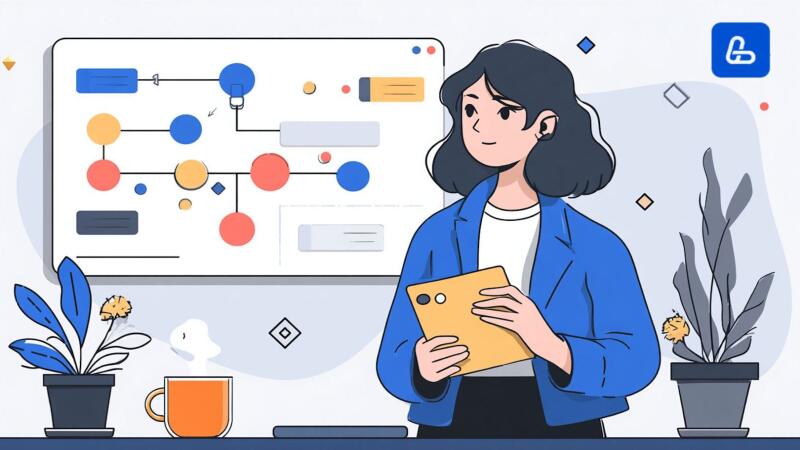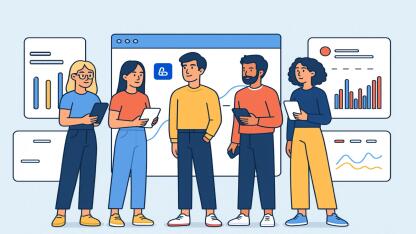Imagine a website with no links between its pages. A user opens the homepage and… can't go any further. A search engine bot visits and indexes one page, leaving the rest invisible.
This is how a site operates without internal linking – it technically exists but fails to realize its potential. It's like a house with rooms but no doors.
In this article, you will learn how to build an effective system of internal links that strengthens your site from within, transforming it from a collection of disparate pages into a single, powerful mechanism.
What is Internal Linking and Why is it Important for Technical Link Building
What is internal linking? Internal linking is a system of hyperlinks connecting pages within a single domain. The mechanism is simple: a click on a link redirects to another page on the same site. Behind this simplicity lies a powerful optimization tool.
Internal linking for SEO serves several key functions:
- Helps search engine bots find and index all pages
- Distributes link equity between pages
- Improves user navigation
- Increases pageviews per session and time on site
- Reduces bounce rate
- Creates thematic connections between content
A clear example: imagine a book without a table of contents or cross-references. You could read it sequentially but couldn't quickly find the information you need or related topics. Internal linking turns your website into a convenient book with thoughtful navigation.
External vs. Technical Link Building: The Fundamental Difference
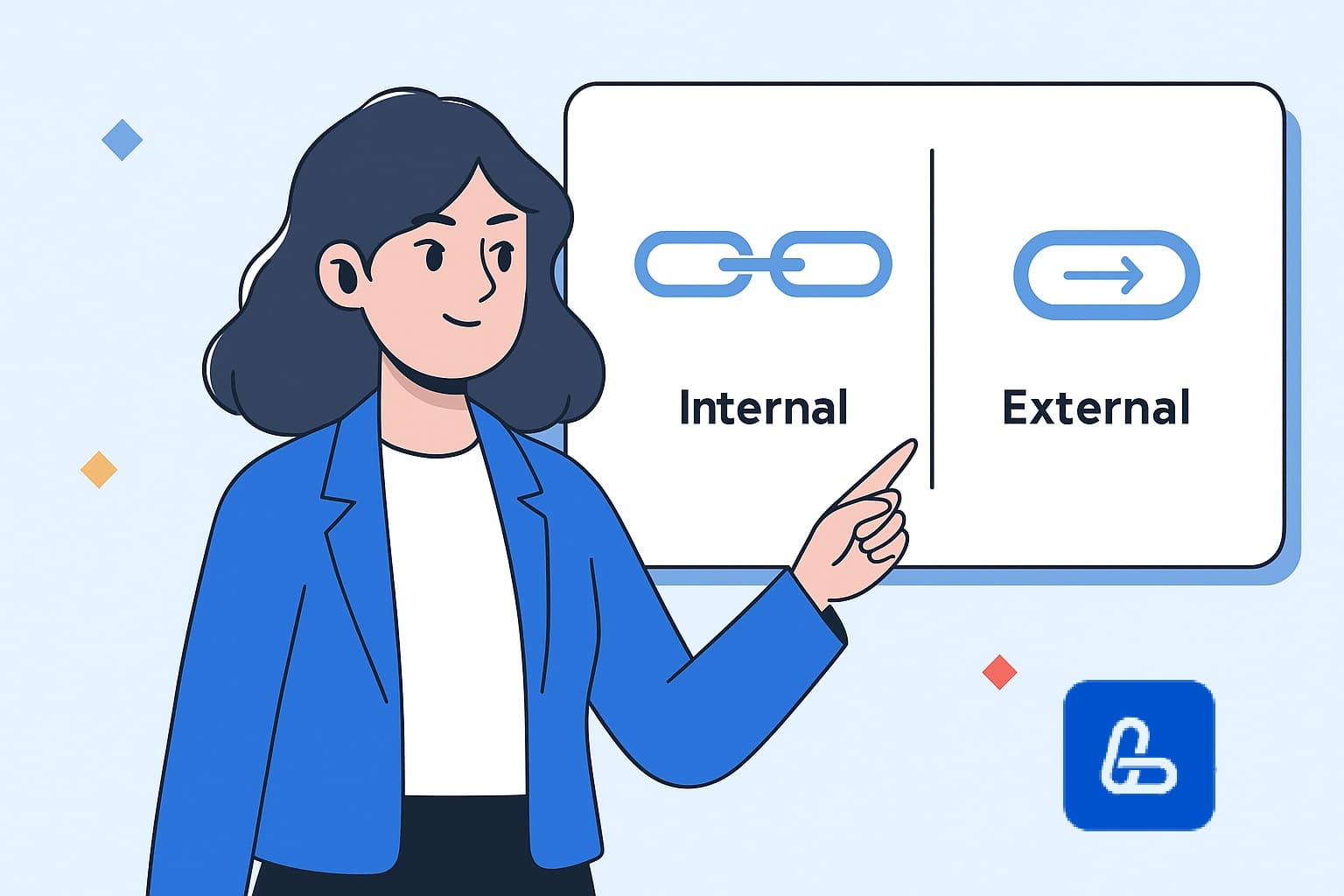
Link building is divided into external and internal (technical). The first is aimed at acquiring links from other websites, while the second focuses on creating an optimal internal linking structure.
External Link Building:
- Increases a site's authority in the eyes of search engines
- Attracts new traffic from other platforms
- Requires interaction with external resources
- Often requires significant time and budget investment
Technical Link Building:
- Distributes the link equity acquired from external sources
- Improves site structure and indexing
- Is entirely under your control
- Requires minimal external costs
These two disciplines work in tandem like a plumbing system: external links are the water entering the house, and internal linking is the network of pipes distributing that water to all the rooms.
Without effective internal linking, the impact of external links is significantly diminished: the water doesn't flow where it's needed or simply goes down the drain.
The Role of Internal Links in SEO: From Navigation and Crawling to Weight Distribution
Internal linking in SEO plays a critical role in several areas:
- Crawling and Indexing. Search engine bots discover pages by following links. Without proper internal linking for SEO, some sections may remain unindexed, especially on large sites.
- Link Equity Distribution. Each page has a certain "weight" or authority. Through internal links, this weight is transferred to other pages, boosting their rankings.
- Improving User Engagement Metrics. Internal linking helps users find related content, increasing time on site and reducing the bounce rate.
- Contextual Signaling. The anchor text of internal links helps search engines understand the topic of the linked-to page.
How Internal Links Amplify the Effect of External Ones: Turning Incoming Link Equity into a Promotion Tool
Internal linking for SEO works as a system for distributing the link equity obtained from external sources.
Imagine: your homepage receives a powerful backlink from an authoritative resource. Without a smart internal linking strategy, this equity remains solely on the homepage, providing no benefit to other sections.
A well-thought-out internal linking system allows you to:
- Direct externally acquired equity to priority pages
- Boost sections that are difficult to promote with external links alone
- Balance the overall link profile of the site
- Reduce costs associated with external link building
Example: a news portal receives powerful external links to its homepage and breaking news articles. Through its system of internal links, this equity is channeled to commercially important sections – premium content, subscriptions, and special projects.
The secret to effective SEO promotion lies in this symbiosis of external and internal link building.
How to Build an Effective Internal Linking Structure for SEO
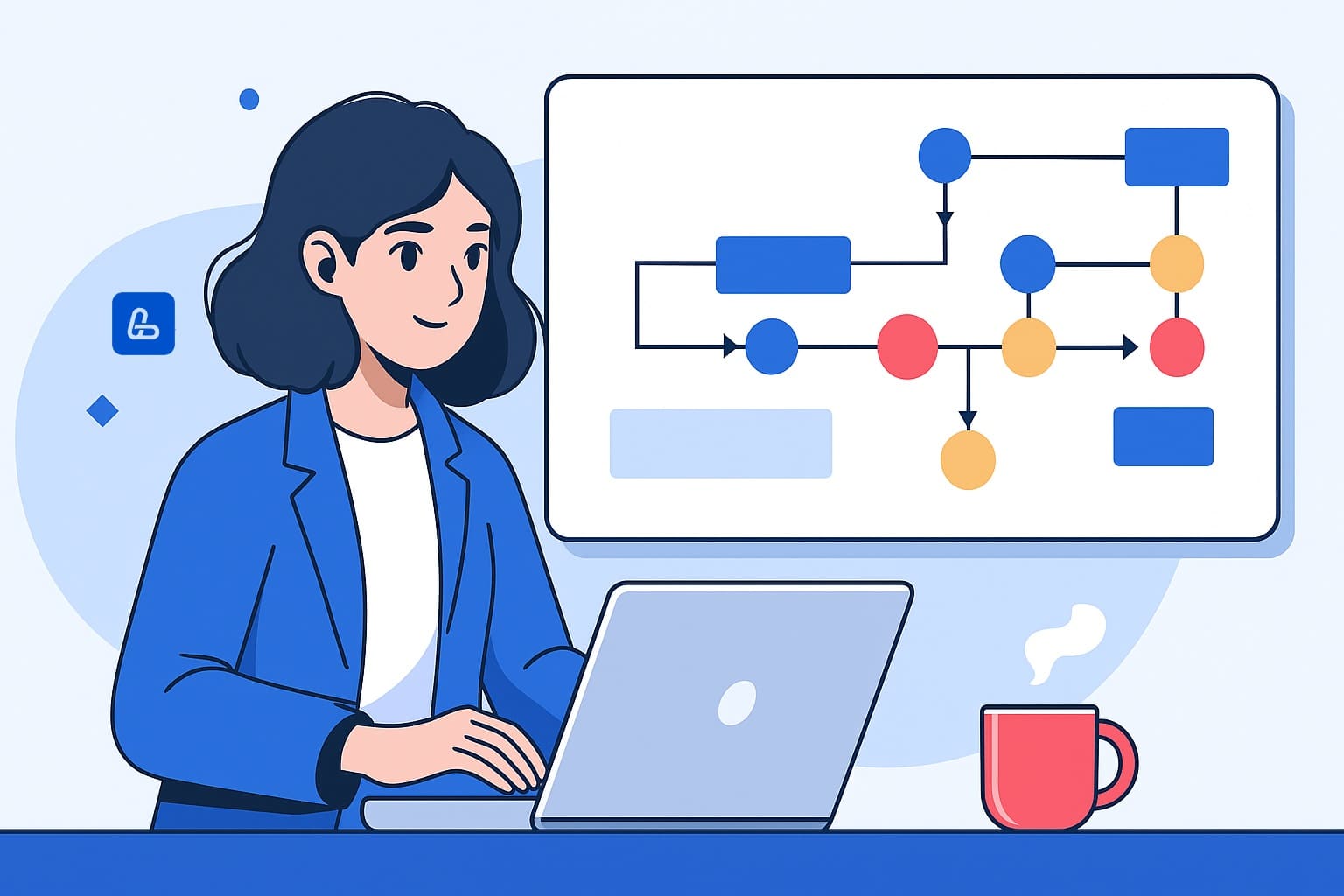
Hierarchical Website Structure (SILO) as the Foundation for Linking
An effective internal linking structure begins with proper site architecture. One of the most effective approaches is a hierarchical structure, or "Silo."
The Silo principle involves grouping content into thematic clusters where:
- The homepage links to main categories
- Categories link to subcategories
- Subcategories link to specific pages
- Pages within the same cluster link to each other
Internal link optimization through a Silo structure offers several advantages:
- Clear thematic segmentation for search engines
- Logical transfer of link equity from general pages to specific ones
- Intuitive navigation for users
- The ability to concentrate link equity in desired thematic clusters
An example of a successful silo structure is an educational platform where content is clearly divided into disciplines, topics, and subtopics, with internal linking within thematic blocks.
An e-commerce store can use a silo structure by dividing products into categories, subcategories, and groups. For example:

Types of Internal Links: Navigational, Contextual, and Site-Wide Blocks
An effective internal linking strategy utilizes different types of links, each with its own role:
- Navigational Links
- Main menu, breadcrumbs, footer
- Provide basic site navigation
- Pass a small amount of weight but are crucial for structure
- Improve usability and reduce click depth
- Contextual Links
- Placed directly within the content text
- Highly valuable for SEO due to surrounding context
- Transfer more link equity
- Often contain keywords in the anchor text
- Site-Wide Blocks
- "Related articles," "Popular products," sidebar widgets
- Help promote selected pages
- Improve user experience
- Shorten the path to important content
- Structural Links
- Pagination, filters, sorting
- A technical necessity for large sites
- Help search engine bots with indexing
- Provide access to all content
Internal links examples of different types can be seen on any major information portal. For example, on a news site:
- Navigation by section (politics, economics, sports)
- Contextual links in articles to related topics
- "Read also" or "Popular this week" blocks
- Pagination for browsing news archives
For example, here’s what navigation looks like on The Argus news portal:

Internal Linking: Examples and Schematics of Main Models
There are several popular linking models:
Linear Model
- Pages are linked sequentially
- Suitable for step-by-step guides, courses, documentation
- Simple to implement but functionally limited
- Example: software setup documentation, a step-by-step recipe

Circular Model
- Pages are linked in a circle
- Useful for thematic sections with content of equal importance
- Ensures good circulation of users and link equity
- Example: a series of articles on one topic, a catalog of similar products

Star Model
- A central page is linked to all others
- Suitable for promoting a key page (landing page, important service)
- Concentrates link equity on the central page
- Example: a service page and related materials about it
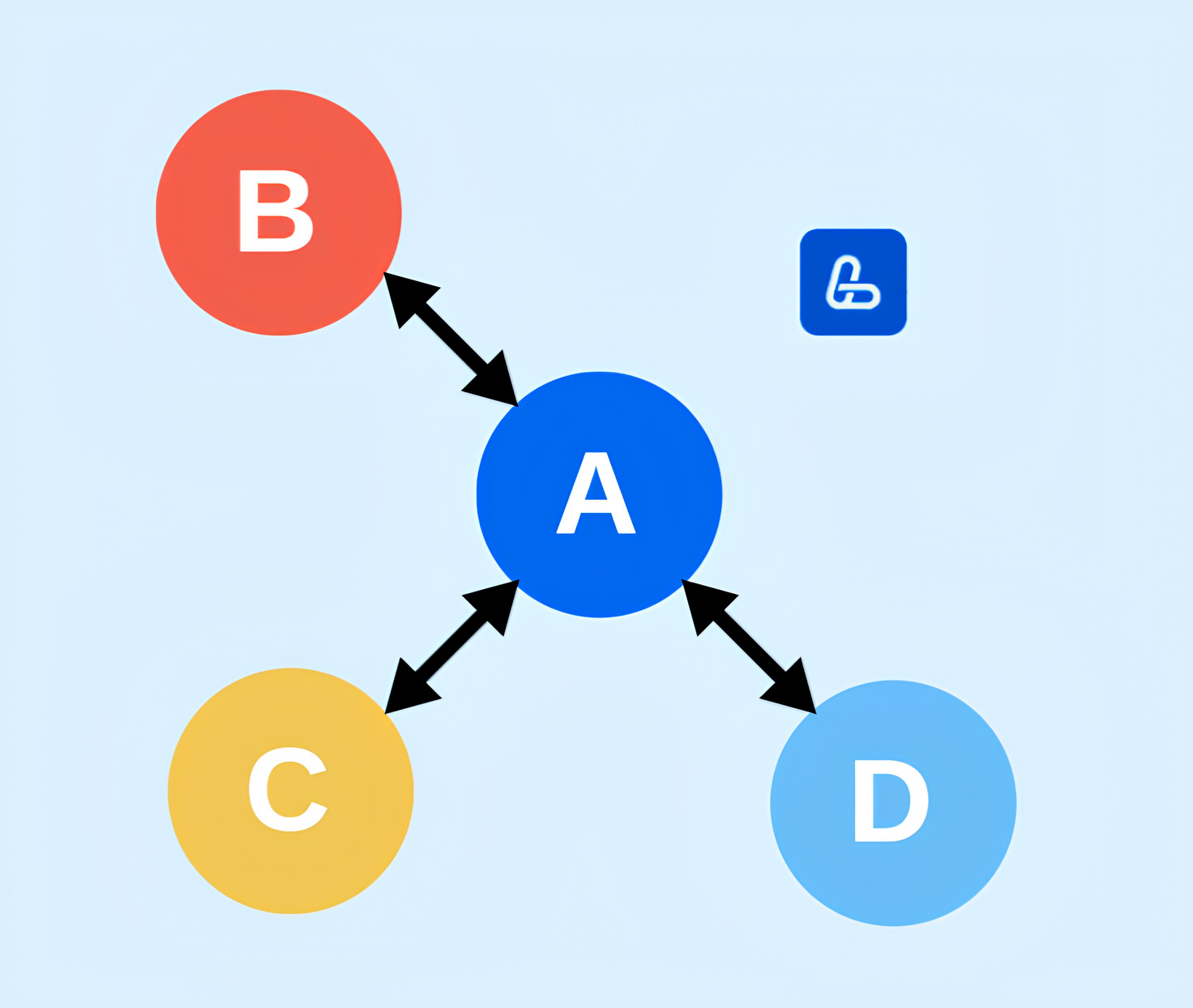
Mesh Model
- All pages are interconnected
- Provides maximum content connectivity
- Can dilute link equity if used incompetently
- Example: encyclopedias, wiki resources
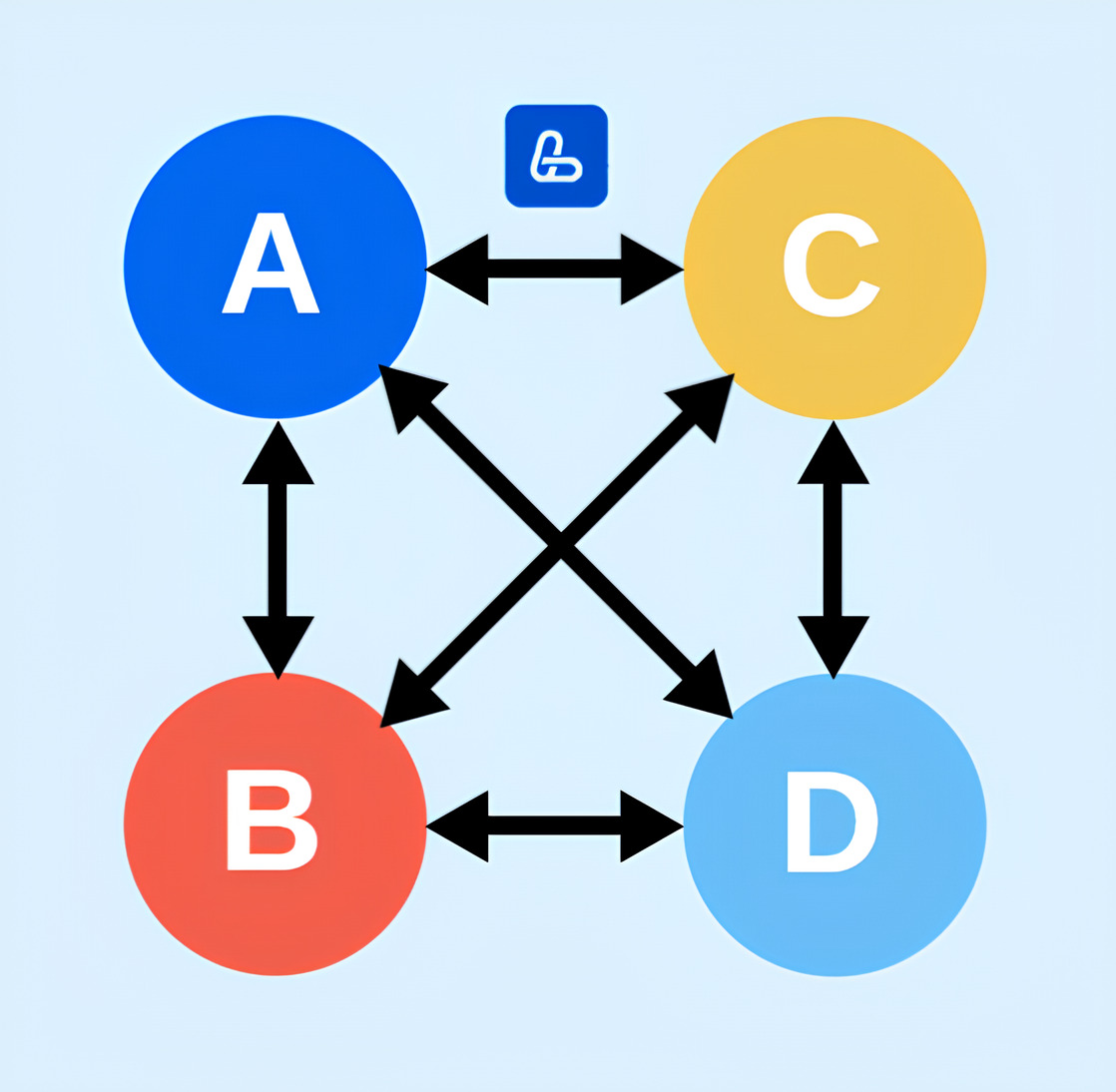
The choice of model depends on the site type, its goals, and content structure. Hybrid models are often used in practice. For example, an online store might use:
- A hierarchical structure for categories and subcategories
- A star model for promoting bestsellers
- A circular model for related products
Click Depth and Flat Structure: Making Key Pages Accessible to Users and Search Bots
Why are internal links important for SEO? Their importance is particularly evident when optimizing click depth – the number of clicks from the homepage to a target page.
Optimal click depth:
- For key pages – no more than 3 clicks from the homepage
- For secondary pages – no more than 5 clicks
- The deeper a page is, the less link equity it receives
- The deeper a page is, the less likely a user is to find it
A flat structure helps reduce click depth without disrupting the site's logic. Instead of a deep hierarchy (A → B → C → D → E → F), a flatter one is created (A → B → F).
Methods for creating a flat structure:
- Cross-linking between sections of the same level
- Additional navigation blocks for important pages
- Site-wide links in the footer to key pages
- "Popular pages" or "Important sections" blocks
- Tag clouds for informational resources
How does internal linking help SEO in reducing click depth? It's visible on major e-commerce platforms. There, products are accessible via the catalog, search, various selections on the homepage, and through recommendations on other product pages.
Compare:
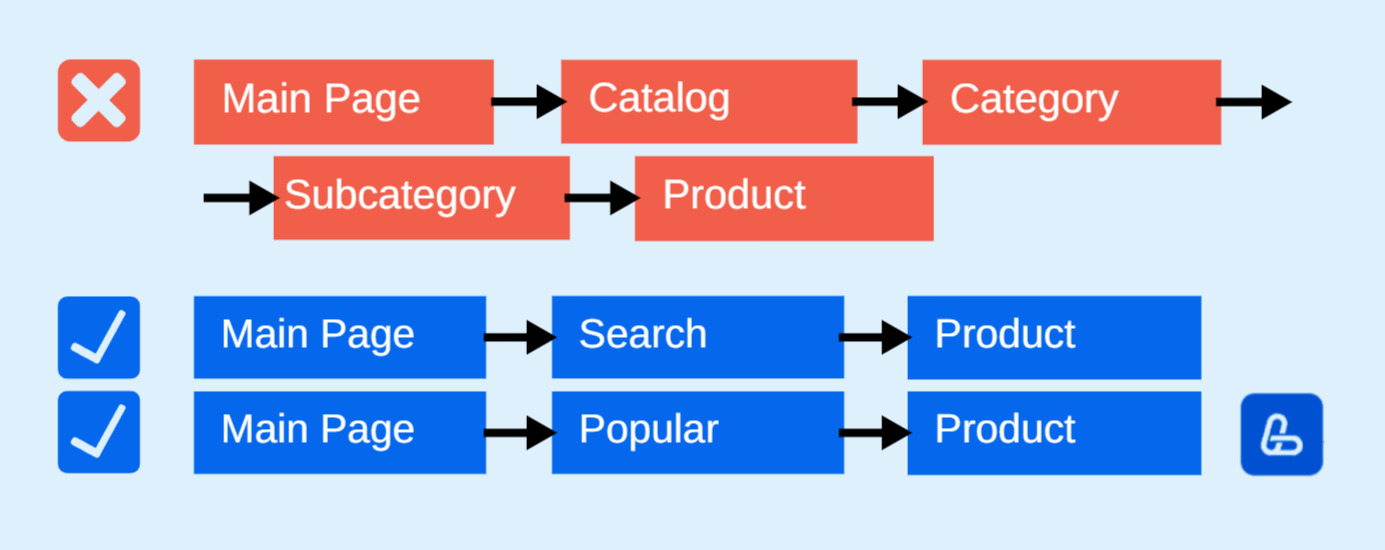
Link Equity Distribution: Managing the Power of External Links Through Internal Linking
What is PageRank and Link Equity: A Brief on the Mechanics
What are internal links from a link equity transfer perspective? They are a system for distributing authority between pages.
PageRank – a Google algorithm that assesses a page's importance based on the number and quality of links pointing to it. Although Google no longer publishes PageRank values, the principle of passing weight through links remains fundamental to ranking.
Key principles of link equity:
- Each page has a certain amount of link equity
- A portion of this equity is passed through outbound links
- The more outbound links, the less equity is passed through each one
- The weight passed via a link depends on the importance of the linking (donor) page
- Cyclical links reduce the efficiency of weight transfer
The benefits of internal linking for SEO lie in the ability to direct this equity to priority pages, enhancing their positions in search results.
Strategic Goals: Which Pages to Direct Equity To
Internal linking for SEO requires a strategic approach to link equity distribution.
Linking priorities:
- Commercial Pages
- High-margin service or product pages
- Pages with high conversion rates
- Landing pages for advertising campaigns
- Seasonal offers and promotions
- SEO-Important Pages
- Pages optimized for highly competitive queries
- Pages struggling to rank
- New pages that need faster indexing
- Pages recently updated significantly
- Content Pages with High Conversion Potential
- Detailed product guides
- Reviews and comparisons
- Case studies and success stories
- Expert articles that build brand trust
Important: the weight distribution strategy must align with business goals. There's no point in boosting pages with low conversion rates or margins just because they rank well.
The Nofollow Attribute for Internal Links: When and Why to Use It
When implementing internal linking, it's crucial to use standard (dofollow) links to consciously distribute page authority across the site. This helps search engines find and rank key content correctly. Links to key articles, services, and products should be without additional attributes – this is the foundation of SEO.
Sometimes a link is present, but passing weight through it is unnecessary or even harmful. In such cases, the rel="nofollow" attribute is used. It tells search engine robots: "Do not follow this link and do not count it when calculating the page's authority."
When should you use nofollow internally?
- Links for functionality and actions. For example, "Add to cart," "Checkout," "Log in" buttons. Their purpose is user action, not weight transfer.
- Links to non-indexable content. You have pages blocked from indexing by robots.txt or a noindex meta tag (e.g., login page, payment terms). When you link to such pages, apply the nofollow attribute. This helps avoid conflicting signals for search engines.
- Links in widgets and templates. Links repeated on many pages (e.g., "Popular products," "Random article") can dilute weight. Nofollow can help focus it on the main pages.
- Paid placements and advertising. If you advertise a partner product or a paid guest post on your site, such a link should be nofollow.
- Conditional or untrusted content. For example, links in user comments or to unvetted reviews. This protects your site from potential negative impact.
Direct the main flow of weight to priority pages using dofollow links. And nofollow is a precise tool for exceptions that helps control this flow and comply with search engine guidelines.
How to Calculate the Optimal Number of Links on a Page
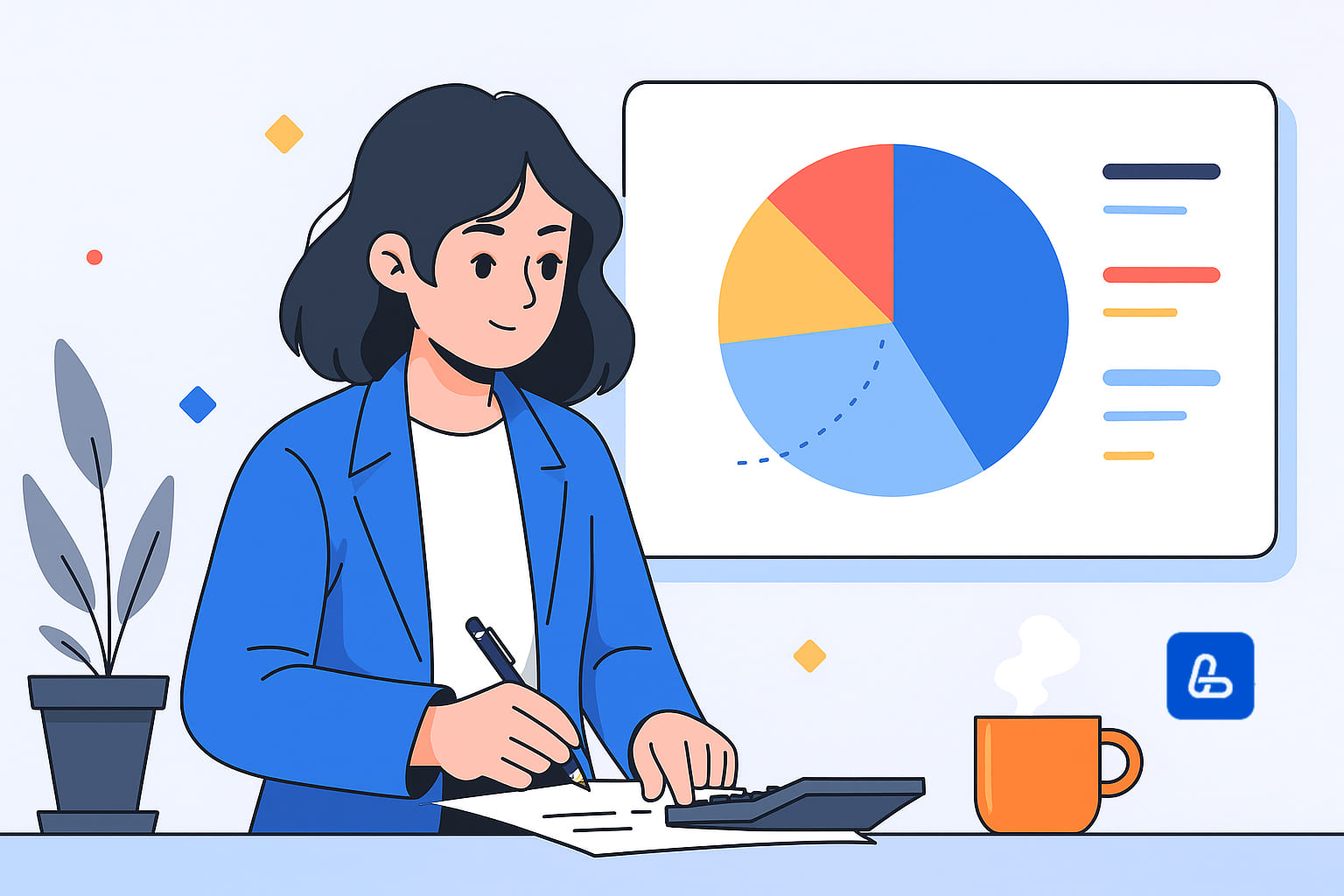
Internal linking should be balanced. An excessive number of links reduces their SEO value, while a lack of them complicates navigation.
There is no universal magic number to "calculate." Search engines no longer set hard limits like they used to. It's not about the quantity but the purpose and quality.
Basic calculation rules:
- The main principle is user priority. Ask yourself: are all the links useful to the visitor? Do they help solve his problem? Do they lead to relevant content? If yes, then their quantity is less critical. If links are added "for the sake of it" or clutter the page – that's bad.
- Focus weight on what's main. Think about weight distribution on the page. Each link is a part of it. If a page has 100 links total, but 90 of them are in the menu, footer, and widgets? This is a reason to use nofollow for secondary blocks, leaving dofollow only for key recommendations in the text.
- Structure is your best friend. Break down links into logical groups:
- Navigational: menu, breadcrumbs, pagination. Many of these can use nofollow.
- Contextual: the most valuable links in the body of the article, leading to other useful materials. These should be dofollow and added thoughtfully.
- Secondary: footer, links to policies, social media.
Don't calculate a number, calculate usefulness. Analyze your page: keep only the necessary navigational and contextual links, and either remove the rest or add the nofollow attribute. Link quality is always more important than quantity.
Practical Guide: How to Implement Internal Linking for Site Promotion
Even the most expensive backlinks won't bring benefits if internal weight is distributed incorrectly. Let's figure out how to create an internal linking system from scratch.
Semantic Core Analysis and Clustering as the Foundation for Link Structure
Imagine you're building a house. The semantic core is a pile of bricks. If you just haul them around without a plan, you'll get a shapeless pile, not a solid building. Clustering is that architectural plan that groups bricks (queries) for different parts of the house (site pages).
How is this related to links? Very simply! Each cluster is a thematic group of queries that you address with one landing page. This page becomes the primary target for your internal links.
Here's how it works in practice:
- Identify main pages. Clustering clearly shows which key "hub" pages you have (e.g., "buy a sofa," "apple charlotte recipe," "how to apply for a credit card"). These are powerful nodes in your link network.
- Build logical connections. Pages within the same cluster are closely related in meaning. The article "how to choose a sofa" should link to the main "sofas" category page and to specific model cards. Search engines see this logic and correctly understand your site's structure.
- Write anchor text. When linking from supporting articles to the main cluster page, you can use relevant anchors (exact match and diluted queries). This gives a clear signal about the target page's topic.
Without clustering, internal links are placed chaotically. You might link from an article about credit cards to a recipe for charlotte just because it's popular. This dilutes thematic weight and confuses robots.
With clustering, you create a meaningful web where weight purposefully flows from secondary pages to the main ones in each cluster, strengthening them in search results for your target queries. This is the foundation for smart weight flow control.
The main stages of working with semantics for linking:
- Collecting a full semantic core
- Commercial queries (buy, price, order)
- Informational queries (how to choose, what is)
- Brand queries (company name, product name)
- Related queries (accessories, additions)
- Clustering by topic
- Grouping queries into semantic groups
- Identifying connections between clusters
- Determining main queries in each cluster
- Identifying micro-topics within clusters
- Matching clusters to pages
- Each cluster = target page
- Identifying missing but necessary pages
- Identifying duplicate pages
- Determining pages that can be merged
Based on clustering, a primary scheme of connections between pages is created: pages from related clusters should be linked. This approach ensures the thematic relevance of the internal linking and logical structure for users and search engines.
Creating a Linking Map: Identifying Main Donor and Acceptor Pages
Internal linking requires a clear plan – a linking map.
Stages of creating a map:
- Identifying donor pages
- Pages with high link equity (homepage, popular sections)
- Pages with a large number of external links
- Pages with high organic traffic
- Pages high in the site hierarchy
- Pages with good indexing
- Identifying acceptor pages
- Commercially important pages
- Pages struggling to rank
- New pages requiring indexing
- Pages targeting highly competitive queries
- Pages with high conversion potential
- Creating a linking matrix
- A table where rows are donor pages, columns are acceptor pages
- Setting priorities: how many links and from which pages are needed
- Planning anchors for each connection
- Determining link types (contextual, blocks, menu)
For example, here’s what a linking matrix might look like for a website dedicated to healthy eating. The pages in the column headers are those to which we place a link. The pages in the rows are those from which we link.
| Donor / Acceptor | Homepage | Healthy Recipes for Every Day | How to Count Calories | Best Recipes for a Slow Cooker | Top 10 Healthy Breakfasts |
|---|---|---|---|---|---|
| Homepage | – | Anchor: "Simple Healthy Recipes" | Anchor: "Calculate Calories" | Anchor: "Cooking in a Slow Cooker" | Anchor: "Breakfast Ideas" |
| Healthy Recipes for Every Day | Link in menu | – | Anchor: "how to correctly calculate the calories in a dish" | Anchor: "tasty slow cooker recipes" | Anchor: "tasty and healthy breakfasts" |
| How to Count Calories | Link in breadcrumbs | Anchor: "recipe examples with calorie calculation" | – | – | Anchor: "how many calories in popular breakfasts" |
| Best Recipes for a Slow Cooker | Link in menu | Anchor: "more healthy recipes" | Anchor: "calculate the calorie content of a finished dish" | – | Anchor: "healthy breakfast in a slow cooker" |
| Top 10 Healthy Breakfasts | Link in menu | Anchor: "recipes for proper nutrition" | Anchor: "calorie content of the presented breakfasts" | Anchor: "cook in a slow cooker" | – |
This approach helps systematize the work and not miss important connections between pages.
Contextual Linking: Best Practices for Using Anchors
Contextual links are among the most valuable elements of internal linking in SEO. They are organically woven into the text and have high relevance.
Here are a few simple rules to make your linking natural and effective.
- Naturalness comes first. Write anchors for people, not robots. The link should fit organically into the sentence. Instead of the cumbersome "In our article about what link popularity is and how to build internal links for seo to improve it, you will find many useful tips," use: "Our detailed guide will help you improve your link popularity."
- Avoid monotony. Use not only exact match keywords ("buy sofa") but also their synonyms, colloquial variations, and descriptive anchors:
- Exact query: buy sofa
- Synonym: purchase a sofa
- Colloquial: sofas in an online store
- Descriptive: these models will fit perfectly into the living room
- Non-anchor link: read more about this here
- Match the content. The anchor should accurately reflect what the user will find on the target page. If you're linking to an article about apple pie, the anchor "apple pie recipe" is ideal. Deceiving the user (e.g., an anchor "desserts" leading to a page with appliances) harms trust and SEO.
Imagine you're recommending another article on your site to a friend. How would you describe it? Use that phrase as the anchor.
Site-Wide Blocks and Navigational Elements: How to Optimize Them, Not Harm Them
The menu in the header, lists in the footer, sidebars with popular articles – these elements are on dozens or hundreds of your site's pages. They are a powerful navigation tool, but from a linking perspective, they are a potential threat. Why?
The Problem: Weight Leakage and Useless Links
Imagine that from every page you link dozens of times to the "Privacy Policy" or "Terms of Use." These pages are not commercially important; they don't participate in promotion. But your weight persistently "leaks" to them instead of strengthening key sections.
The Solution: Judicious Use of Nofollow and Noindex
- Assess the necessity. Ask: does the user need this link on this specific page?
- Set priorities. Keep in the main menu only links to the most important sections (catalogs, services, main articles). Everything else is secondary.
- Check technical optimization:
- For utility pages ("Policy," "Terms," "Careers") in site-wide blocks, feel free to use the rel="nofollow" attribute. This preserves user convenience but stops useless weight leakage.
- Don't worry about navigational links that remain dofollow and are repeated on all pages (e.g., "Catalog" in the menu). Search engines recognize such mass links and account for them with a reducing coefficient, lowering their weight compared to unique contextual links in the article text.
- Be cautious with widgets. Blocks like "Popular," "Random Article," "Recent Comments" generate a huge number of similar links. Some of these can also be neutralized with nofollow, especially if they lead to less important pages.
Site-wide blocks and navigation are important components of the internal linking structure. They should help users, not harm SEO. Auditing your site for excessive repetitive links and judicious use of nofollow is a simple way to redirect the weight flow to where it's truly needed.
Relevance and Topical Proximity: Why You Shouldn't Link from a Page About Kettles to an Article About Screwdrivers
Internal linking best practices require thematic proximity between linked pages. Search engines are getting smarter and understand perfectly well whether the topics of two pages are related.
Imagine you're recommending a book to a friend. If you're discussing cooking and recommend a new culinary bestseller – that's appropriate and logical. If in a conversation about repairs you suddenly recommend a detective novel – your friend will be surprised, and the advice will lose value. It's the same on a website.
What are the risks of irrelevant links?
- Poor user experience. A person reading about choosing an electric kettle is unlikely to want to suddenly switch to an article about screwdrivers. This will cause confusion and increase the bounce rate.
- Dilution of topical weight. The search engine sees that you are linking to a page whose topic is far from the context. This weakens the signal about what your site is specifically "about." Instead of clear positioning as an "expert in household appliances," you create chaos.
- Loss of the robot's trust. If such illogical connections are repeated en masse, it can undermine the search robot's trust in your site as a whole.
Use links only to content that logically continues your thought, offers a solution to a related problem, or deepens the understanding of the topic. For example, links from an article about kettles could lead to an article about appliance care, comparison of materials (glass or plastic), or a rating of the best small appliance manufacturers. This is logical and useful for everyone.
How to determine topical proximity:
- Pages in the same semantic cluster
- Pages with overlapping target audiences
- Pages in the same category or section
- Pages with a logical connection (problem → solution, product → accessories)
Examples of correct and incorrect linking:
Correct:
- Article about choosing a kettle → article comparing kettles from different brands
- "Smartphones" category page → page with a review of a popular smartphone
- Windows installation guide → review of antiviruses for Windows
Incorrect:
- Article about choosing a kettle → article about garden tools
- Page about diets → page about industrial equipment
- Book review → catalog of building materials
In practice, placing hundreds of links so that they work as a single mechanism is a complex and painstaking task. An incorrect strategy may not help but harm rankings.
The LinkBuilder.com team is ready to take on this work. Our experts will create a powerful external link profile and optimize the internal linking for maximum effect. We will conduct a comprehensive audit of your site, develop a detailed linking map, and competently distribute page weight to strengthen your key positions in search.
Order internal link building from us – and the results will surely please you.
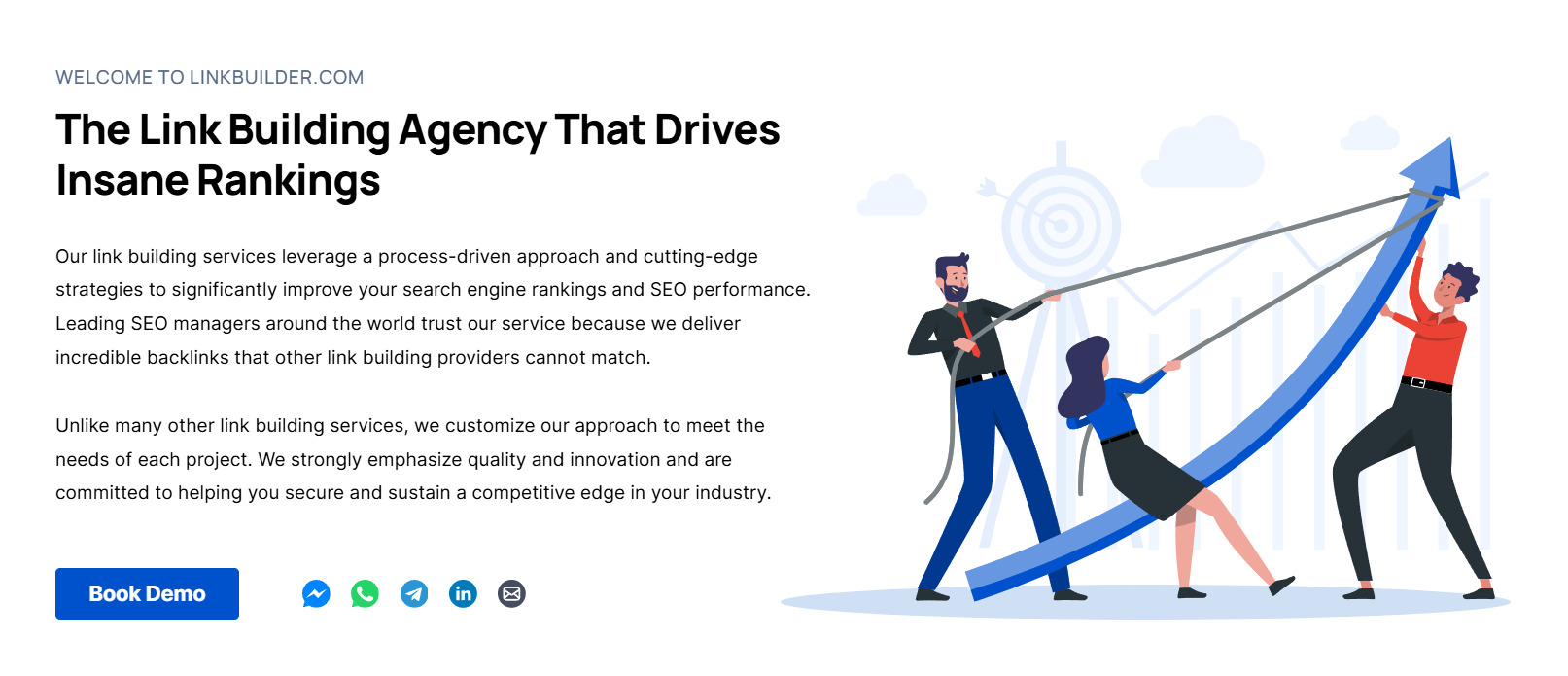
Tools and Methods for Auditing the Internal Link Structure
Before improving anything, you need to understand the current state. This is especially important for the internal linking of a site. Without analysis, you risk breaking working elements and missing real problems.
Built-in Reports: Google Search Console
Google Search Console offers a free and informative report on internal links. In it, you will learn which pages of your site are most popular among them.
How to use the internal links report in GSC:
- Log in to Google Search Console and select the desired site
- In the left menu, find the "Indexing" → "Links" section
- Go to the "Internal links" tab

This report helps:
- Identify pages with an excessive number of inbound links
- Discover important pages with an insufficient number of links
- Compare the actual internal linking structure with the planned one
- Determine if the number of links corresponds to the page's importance
GSC limitations:
- The report shows only 1000 pages (with the most links)
- No data on link types (contextual, navigational)
- No information on anchors
- No ability to filter by page types
Despite the limitations, this is an excellent starting point for analyzing internal linking for SEO.
Audit Platforms: Semrush, Ahrefs, Moz Link Explorer for Comprehensive Analysis
Professional SEO platforms provide deep capabilities for analyzing internal linking for site promotion.
Semrush
The Site Audit tool in Semrush includes a special Internal Linking section that allows you to:
- Identify pages without internal links (orphan pages)
- Discover pages with an excessive number of internal links
- Find pages with incorrect navigation structure
- Analyze redirect chains
- Get recommendations for internal link optimization
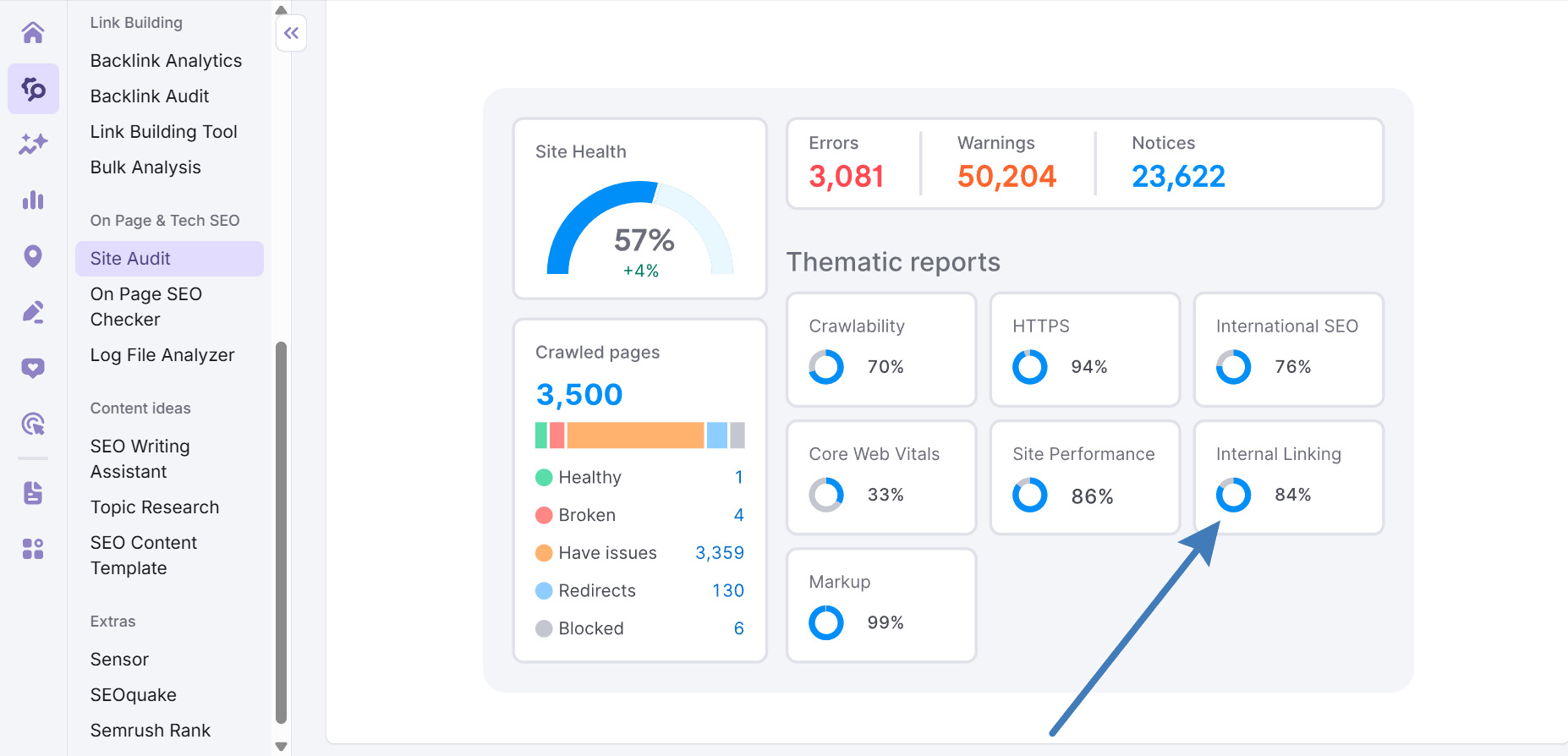
Ahrefs
The Site Audit tool in Ahrefs shows the Internal pages section. There you can see the number of inbound links, broken links, and redirects.
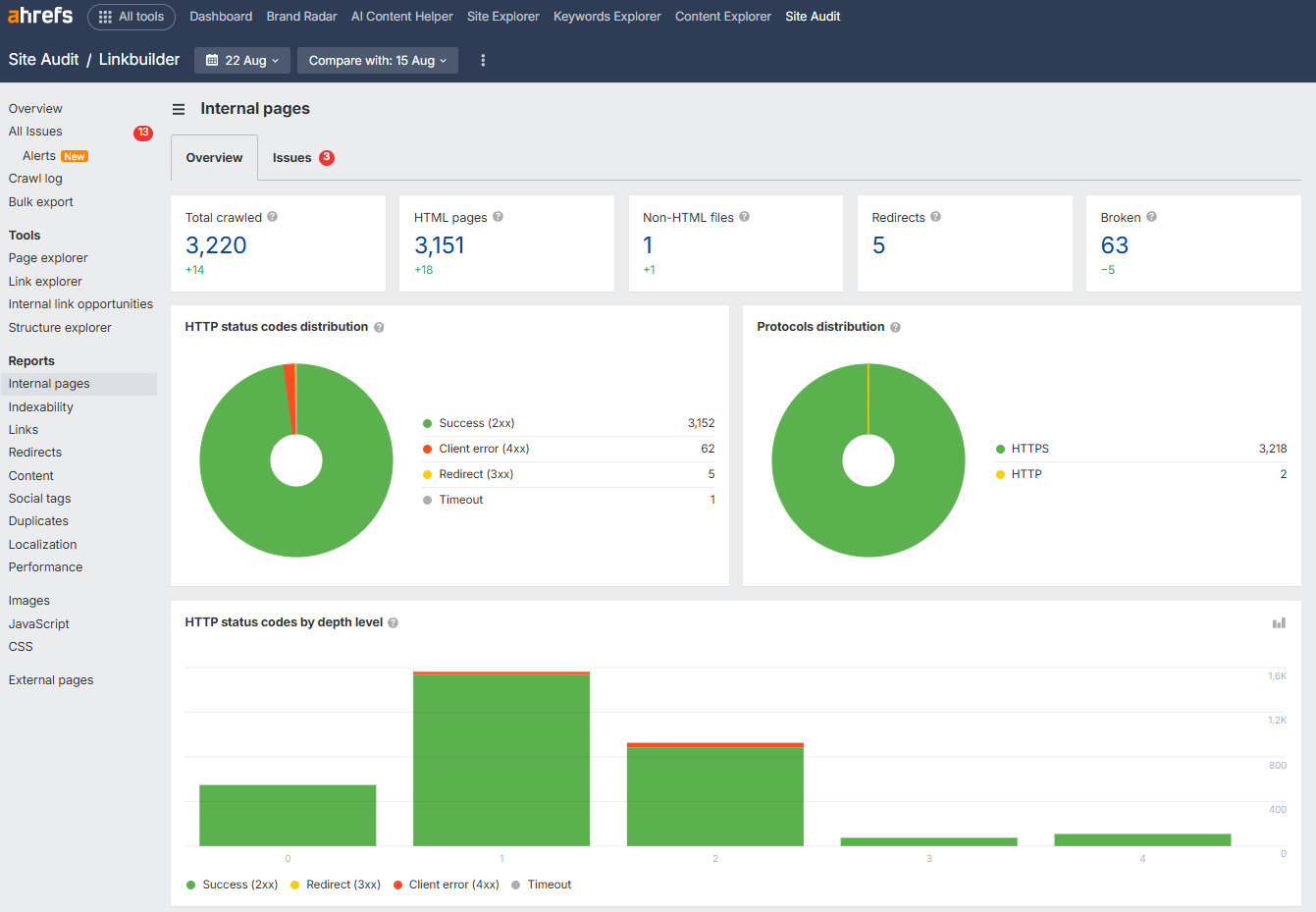
Internal links can also be viewed via Site Explorer → Internal links. This section shows links to a selected page or domain. They can be filtered by type, HTTP status, and nofollow attributes.

Moz Link Explorer
The service is primarily designed for working with external links, but there are also tools for working with internal ones. They allow you to:
- Measure Page Authority (PA) for internal pages
- Identify key pages with high internal authority
- Determine potential for improving linking
- Compare linking with competitors
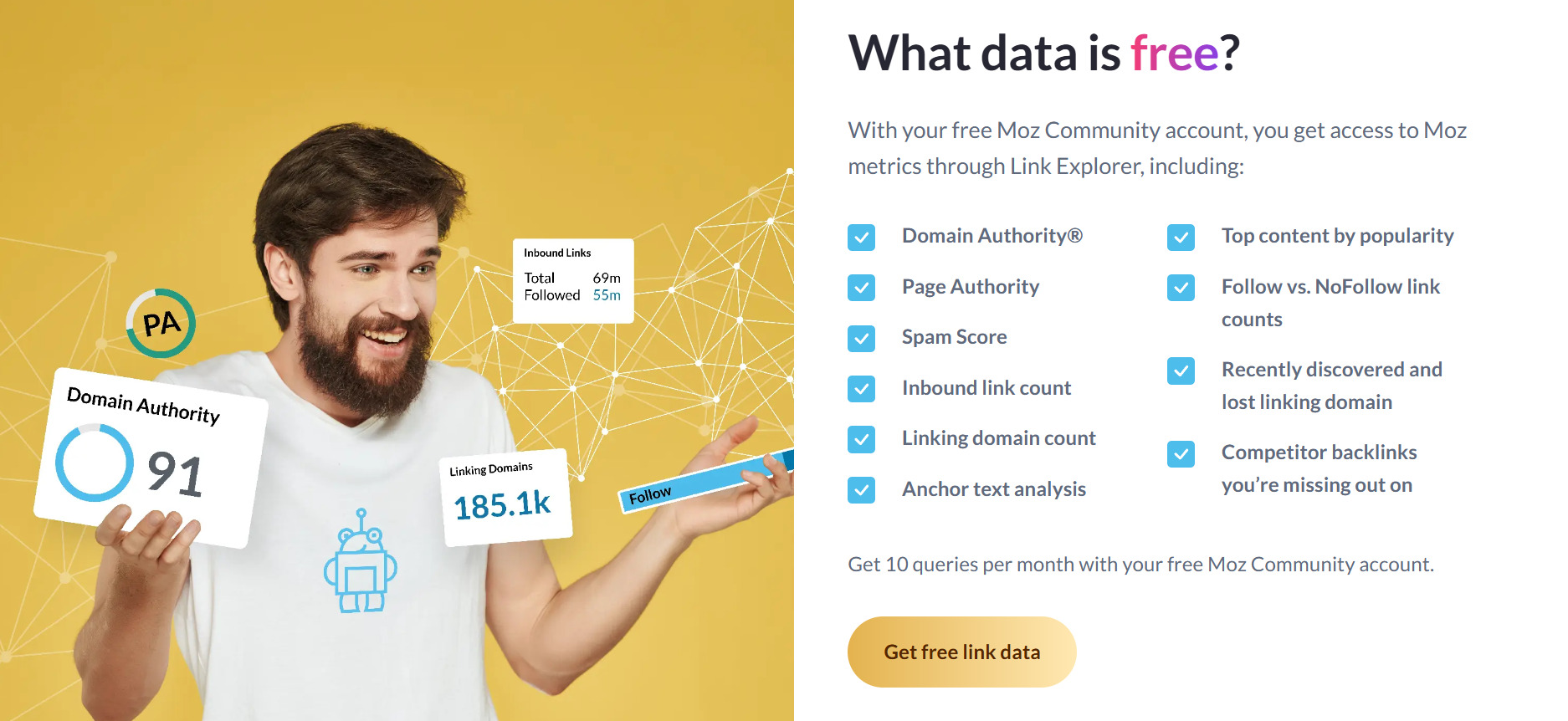
These tools allow for a comprehensive analysis and identify both technical problems and strategic opportunities for improving internal linking.
Site Crawling: How to Use Screaming Frog SEO Spider to Identify Problems
Screaming Frog SEO Spider is another powerful tool for analyzing internal linking. It allows you to "see" the site through the eyes of a search engine robot.
Key capabilities of Screaming Frog for linking analysis:
- Internal Link Analysis
- Complete list of all internal links
- Number of inbound and outbound links for each page
- Anchor text analysis
- Identification of pages with excessive or insufficient links
- Problem Identification
- Detection of broken links (404 errors)
- Search for redirects and redirect chains
- Identification of pages with duplicate content
- Search for orphan pages (without inbound links)
- Structure Analysis
- Visualization of the site's link structure
- Determination of page depth (number of clicks from homepage)
- Site architecture analysis
- Identification of Silo structure problems

How to use Screaming Frog to audit internal linking for SEO:
- Start crawling
- In "Configuration → Spider → Limits," disable crawling depth limits.
- For large sites, crawl by segments.
- Start scanning the site.
- Check page depth
- In the "Links" tab, sort by Crawl Depth (from highest to lowest).
- Export pages with depth >3 to Excel.
- Bring important pages closer to the homepage by adding them to navigation or relevant content.
- Find weak pages
- In "Links," sort by "Unique Inlinks" (ascending) or check "Link Score."
- Find pages with a low number of links and add links from popular pages.
- Fix non-descriptive anchors
- In "Configuration → Spider → Preferences," set non-descriptive anchors (e.g., "learn more").
- After crawling and analysis, find them in "Links → Non-Descriptive Anchor Text."
- Replace them with descriptive anchors.
- Discover orphan pages
- Connect Google Analytics/Search Console via "Configuration → API Access."
- Find pages without inbound links in the "Internal" tab.
- Delete, redirect, or link them to the site.
For large sites, it is recommended to use additional scanning and filtering settings to focus on the most important aspects.
Key Metrics for Analysis: Number of Inbound Internal Links, Citation Index, Click Depth
After you've built your linking, it's important to understand how effective it is. Here are three simple but important metrics to monitor.
Number of Inbound Internal Links
The number of inbound internal links is a direct indicator of a page's importance within your own site, showing how many times it is linked to from other sections.
- Why monitor it? This is a direct indicator of a page's importance in your own structure. If your key commercial page or main article has few inbound links, it's a signal that the linking needs to be revised.
- What to do? Ensure your priority pages (target queries, commercial sections) have the highest number of quality, relevant links from content.
Internal Citation Index (Internal PageRank)
The internal citation index is a "map" of link equity distribution within your site. It's not a metric per se, but rather an analytical model that shows how PageRank circulates through your pages thanks to your own internal links.
- Why monitor it? It helps visualize the weight flow. You can see if important sections are "sagging" due to lack of attention.
- What to do? Use services for analyzing internal links. Their reports clearly show which pages are the main "donors" and which are "acceptors," and if there is any imbalance.
Click Depth
Click depth is a metric that shows how many clicks from the homepage it takes to reach the desired page. Pages that require 5 clicks receive less attention from search engines than those just 2 clicks away from the homepage.
- Why monitor it? High click depth often indicates poor navigation and complex site architecture. Robots and users may simply not find your valuable content hidden deep inside.
- What to do? Strive for all key pages to be accessible in no more than 3 clicks from the homepage. Add direct links from new content to deep but important pages to "pull" them closer to the surface.
By monitoring these metrics, you move from intuitively placing links to managing the site's internal weight based on data. This allows you to identify problems in internal linking for site promotion and determine directions for optimization.
Common Mistakes in Technical Link Building That "Kill" Link Effectiveness
Even when actively working on internal linking, you can make mistakes that negate all efforts. Let's look at typical problems we often see during site audits.
Creating Link Swamps: Uncontrolled Linking of Everything to Everything
One of the most common mistakes is creating "link swamps," where every page links to many others without considering thematic relevance and hierarchy.
Signs of a link swamp:
- A page has more than 100-150 outbound links
- Links lead to pages on different topics without a logical connection
- There is no hierarchy or prioritization of links
- Many links lead to insignificant or technical pages
Consequences:
- Dilution of link equity
- Difficulty for search robots in determining priority pages
- Confusion for users
- Loss of focus and clear site structure
How to avoid:
- Set a limit on the number of outbound links from a single page
- Prioritize links by importance and relevance
- Use thematic clusters and Silo structure
- Regularly audit and remove unnecessary links
Ignoring Relevance When Linking Pages
Links between irrelevant pages degrade the user experience and negatively impact search engines.
Examples of irrelevant links:
- From an article about growing roses to a page with computer repair services
- From a smartphone review to a page about choosing baby food
- From a router setup guide to a page about fashion trends
Consequences:
- Reduced user trust in recommendations
- Increased bounce rate
- Decreased topical authority of pages
- Inefficient transfer of link equity
How to ensure relevance:
- Use the results of semantic clustering
- Link pages from the same thematic group
- Create logical chains of related content
- Think about the user journey and audience interests
Ignoring Orphan Pages That Receive No Weight
Orphan pages are pages that have no internal links from other pages on the site. They may be indexed if they have external links or are listed in the sitemap, but they do not receive internal link equity.
Reasons for orphan pages:
- Technical errors when creating or updating the site
- Changing the structure without updating links
- Forgotten old pages that are still indexed
- Specially created target pages for advertising
Problems:
- Poor indexing of such pages
- Lack of link equity, reducing chances for high rankings
- Loss of conversion potential
- Fragmentation of the site structure
How to find and fix:
- Use Screaming Frog to find orphan pages
- Check server access logs to identify pages visited by users but not linked to the main structure
- Compare URLs in Google Analytics with URLs that have internal links
- Integrate orphan pages into the site structure through relevant sections
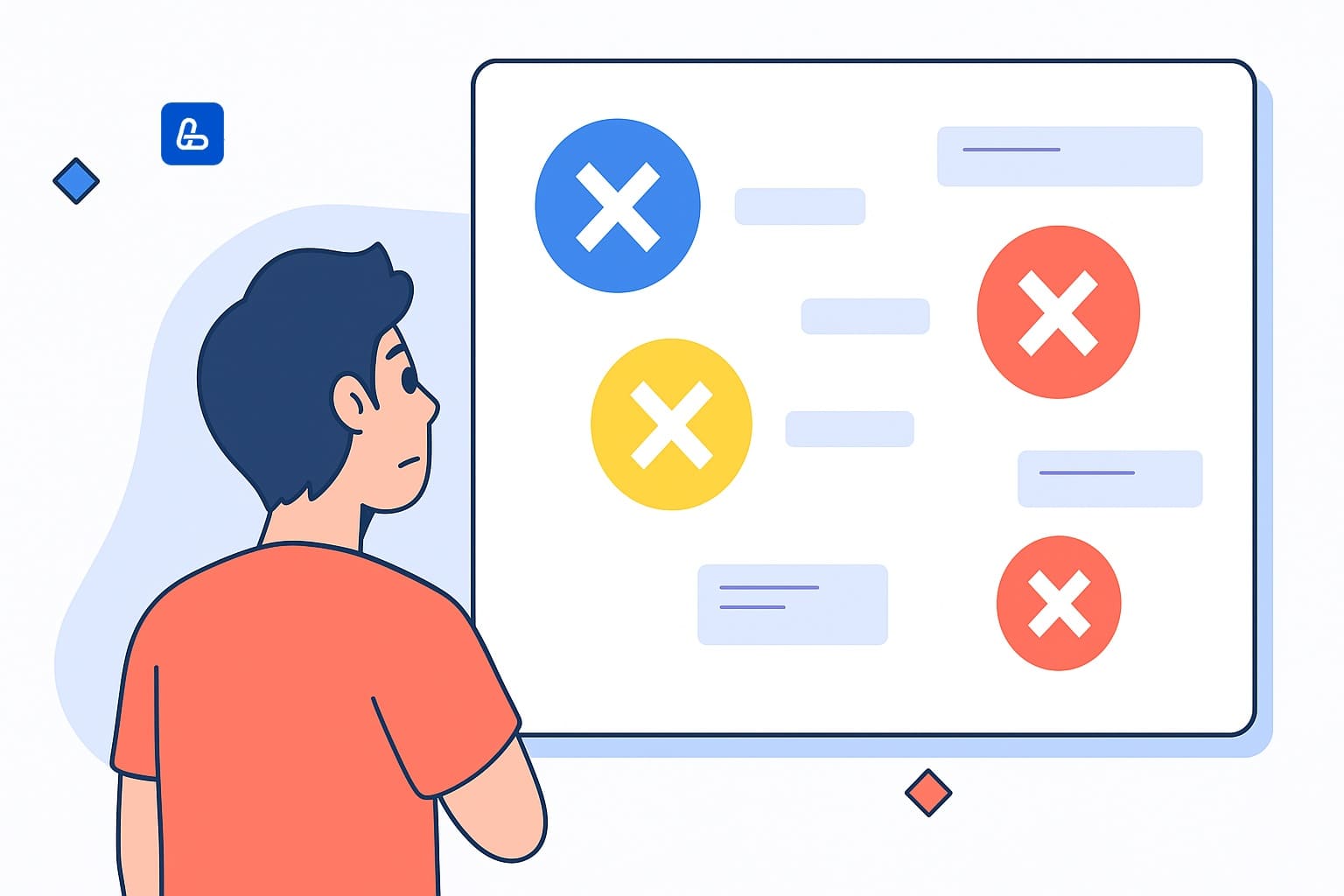
Anchor Over-Optimization: Unnatural Clustering of Exact Match Keywords
Over-optimization of anchor texts is a common mistake, especially among SEO specialists who are too focused on keywords.
Signs of anchor over-optimization:
- Most links to a page use the same anchor
- Anchors contain exact match keywords without variations
- Anchors look unnatural in the context of the sentence
- Overly long anchors including several key phrases
Consequences:
- Risk of penalties from search engines
- Unnatural appearance of content for users
- Reduced link click-through rate
- Loss of user trust
How to avoid:
- Use varied anchors for links to the same page
- Include brand and generic anchors ("learn more," "read more here")
- Ensure the anchor is naturally included in the context
Non-Canonical Pages Receiving the Main Weight: Error in Configuring Canonical Tags
One of the technical errors that significantly affects the effectiveness of internal linking in SEO is the incorrect distribution of weight between canonical and non-canonical page versions.
Typical scenarios:
- Internal links lead to URLs with parameters instead of the canonical URL
- Most links lead to the HTTP version, while HTTPS is set as canonical
- Links lead to paginated pages instead of the main category page
- Links to page versions with session or tracking IDs
Consequences:
- Scattering of link equity between duplicates
- Inefficient use of the link budget
- Confusion for search engines
- Risk of indexing non-canonical versions
How to fix:
- Audit all internal links for compliance with canonical URLs
- Configure correct canonical tags
- Fix navigation and templates to use canonical URLs
- Set up redirects from non-canonical versions to canonical ones
- Regularly check with tools to identify discrepancies
Neglecting Deep Links and Overemphasis on the Homepage
Many sites suffer from a linking imbalance where most internal links lead to the homepage rather than to deep, thematic pages of the site.
Signs of the problem:
- More than 30% of all internal links lead to the homepage
- Important commercial or informational pages have few inbound links
- The logo in the header is the only link on most pages
- Lack of contextual links between deep pages
Consequences:
- Concentration of link equity on the homepage at the expense of others
- Poor indexing of deep pages
- Reduced topical authority of sections
- Missed opportunities to improve rankings for long-tail queries
How to fix:
- Create a system of cross-links between pages of the same level
- Use "Similar articles" or "Recommended products" blocks
- Develop a strategy for contextual linking in informational sections
- Analyze and maintain a balance between links to the homepage and to deep pages
Broken Internal Links and Redirects
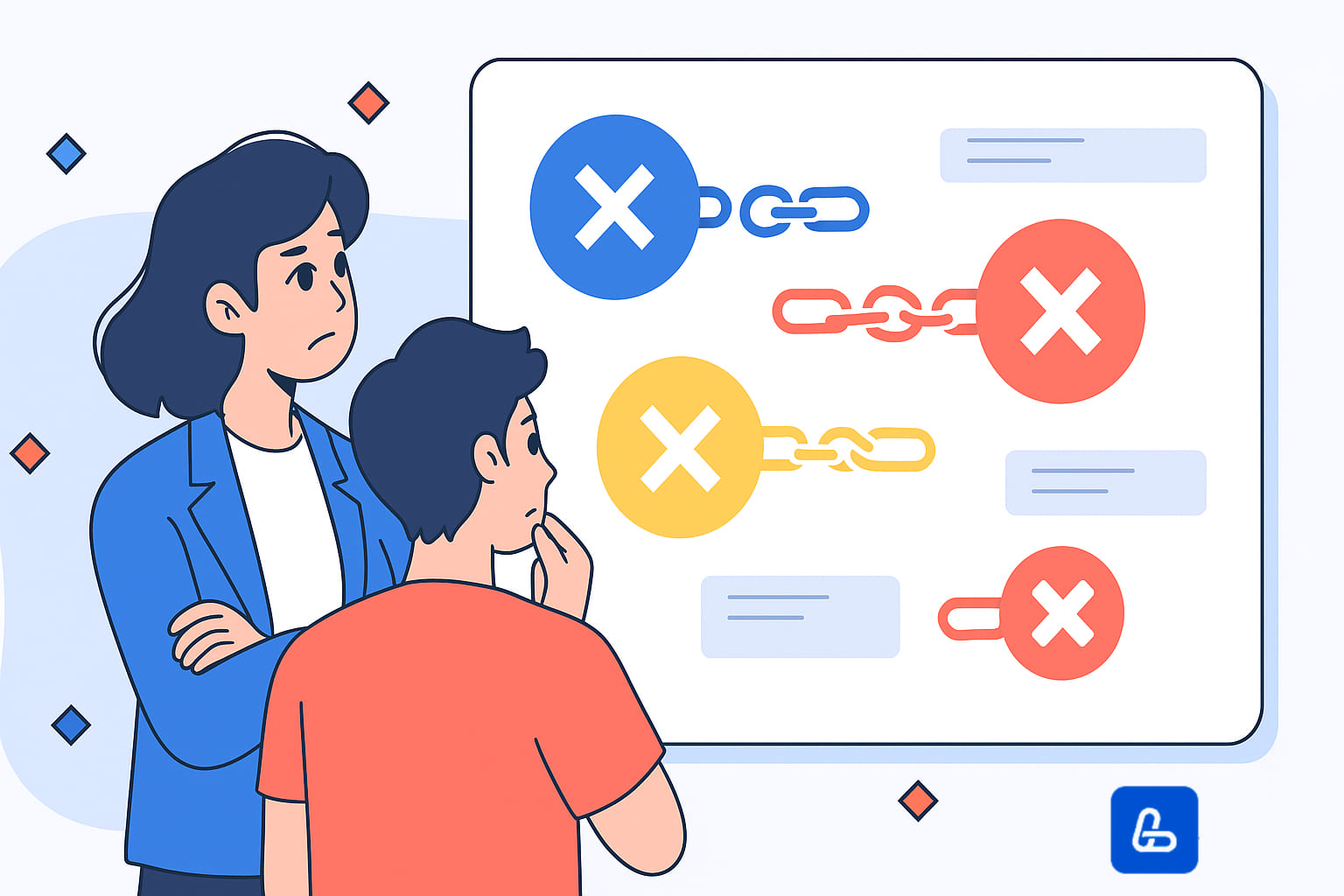
Broken links and chains of redirects are technical failures that degrade internal linking and negatively impact user convenience.
Problems with broken links:
- Users land on pages with a 404 error
- Search robots waste resources crawling non-existent pages
- Loss of link equity
- Negative impact on user experience and trust
Problems with redirects:
- Loss of link equity (about 10-15% per redirect)
- Slowed page load speed
- Increased site crawling time by search robots
- Redirect chains can lead to timeouts
How to identify and fix:
- Regularly scan the site with Screaming Frog or similar tools
- Set up monitoring for broken links in Google Search Console
- Fix links to point directly to target URLs without redirects
- Automate the checking of internal links when updating content
- Create a process for updating links when the site structure changes
How We Integrate Technical Link Building into Comprehensive SEO Promotion at LinkBuilder.com
At LinkBuilder.com, we view internal linking for SEO and external link building as a single whole. Our approach is based on integrating all aspects of link promotion to achieve maximum results.
Why we integrate external and internal link building:
- External links bring authority to the site
- Internal links distribute this authority among pages
- A balanced strategy creates a synergistic effect
- A comprehensive approach allows for more efficient use of the promotion budget
Our process begins with a comprehensive audit that includes:
- Analysis of the external link profile
- Audit of the site's internal linking
- Identification of strengths and weaknesses
- Determination of pages with high growth potential
- Search for unused opportunities
Based on this audit, we develop an integrated strategy that maximizes the effect of every external link acquired.
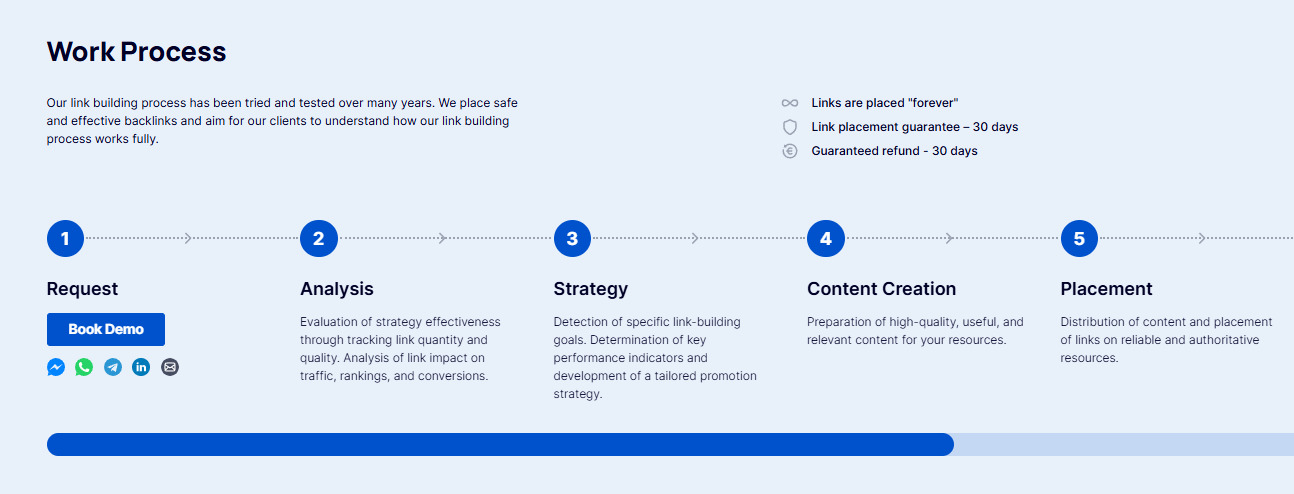
Stage 1: Identifying Growth Points – Which Pages Have Received External Links But Are Not Ranking
The first stage of our work is identifying pages with high potential for rapid growth. We look for pages that:
- Have already received quality external links
- Have relevant and quality content
- Target commercially important queries
- Have not reached their potential in search results
We determine the gap between current positions and the potential provided by external links. This helps identify pages that are underperforming in traffic due to inefficient internal linking.
Stage 2: Developing a Link Equity Redistribution Map
After identifying growth points, we develop a strategy for redistributing link equity. This is a key stage that includes:
- Identifying donor pages
- Identifying acceptor pages
- Developing an internal linking structure
- Creating an implementation plan
- Prioritizing changes
- Implementation schedule
- Metrics for tracking results
- Process for testing and adjustment
The result of this stage is a detailed link equity redistribution map that takes into account business priorities and the site's technical capabilities.
Stage 3: Implementation and Continuous Monitoring of Effectiveness
Implementing a link equity redistribution strategy is not a one-time action but an ongoing process. Our approach includes:
- Phased implementation of changes:
- Starting with priority pages
- Testing various approaches
- Monitoring the impact of changes on rankings
- Adjusting the strategy based on the data obtained
- Key metrics for monitoring:
- Changes in search engine rankings
- Organic traffic to target pages
- User engagement metrics (time on site, pages per session)
- Conversions from target pages
- Regular internal link optimization:
- Analysis of the effectiveness of implemented changes
- Identification of new growth points
- Strategy adjustment based on changes in search engine algorithms
- Adaptation to seasonal factors and changes in business
- Reporting and analytics:
- Regular reports on results
- ROI analysis of implemented changes
- Forecasting further growth
- Recommendations for further optimization
Our approach ensures constant growth and adaptation to changes, which is a key factor for long-term success in SEO.
If you want to maximize the effect of your link building strategy, contact LinkBuilder.com. We offer a comprehensive approach that includes:
- Audit of external and internal link profiles
- Development of an integrated link building strategy
- Optimization of internal linking for maximum effect
- Acquisition of quality external links
- Constant monitoring and optimization of results

Learn more about our technical link building services or schedule a meeting so we can select a set of services specifically for your business.
